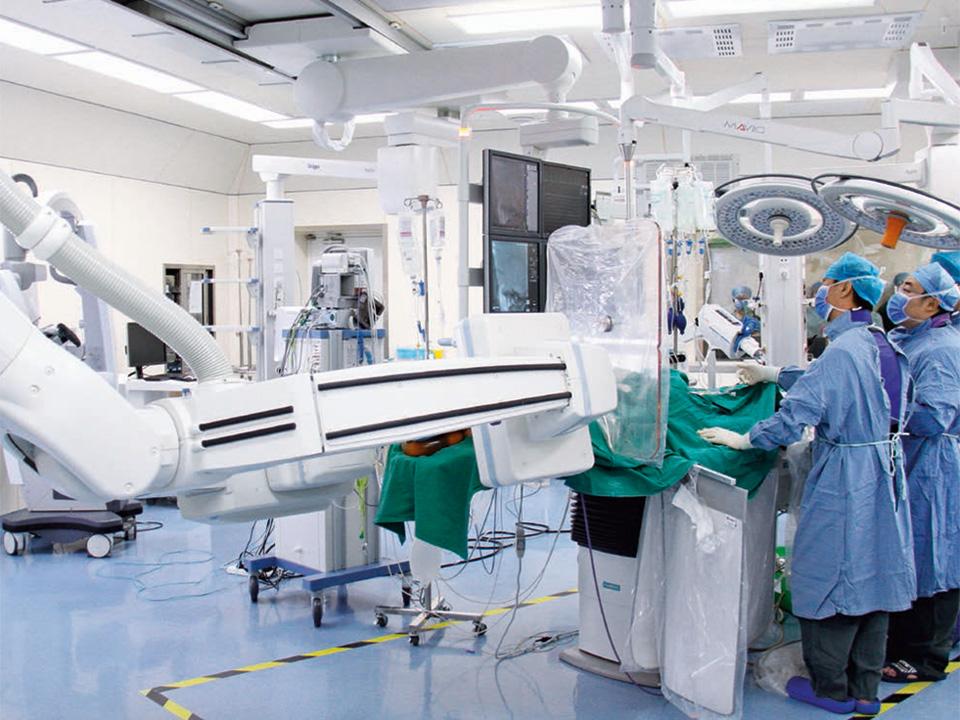Emergency Surgery
The possibility of converting between endovascular and open surgical procedures anytime without any patient transfer is of great importance when dealing with emergency cases. In hybrid operating rooms, intraoperative 3D images can be acquired in less than 5 seconds. Imaging of the head in sitting position is possible with the integration with surgical tables.
Why will endovascular and open surgery be done together? Watch the challenging case in the Medical Knowledge Corner below.
Vascular Malformations
When the patient is positioned on the OR table, the pre-operative location of lesions change with brain shift. The intraoperative syngo DynaCT 3D imaging can provide actual anatomical landmarks and transfer them to the navigation system for precise intraoperative surgical guidance. Especially, the anatomy of the vessels can be seen with great detail in the intraoperative 3D images , which is of highest importance during vascular malformation surgeries.
Discover how intraoperative angiography helps to detect residual AVMs after microsurgical excision in the Medical Knowledge Corner.
Aneurysm Treatments
For neuroendovascular procedures, the Artis biplane technology creates comprehensive 3-dimensional views of the blood vessels in the brain. Equipped with two flat detectors, the Artis zee biplane system offers excellent coverage of the relevant area with fine detail resolution to support you in your decision-making. The flexible positioning of the biplane system enables free head access to anaesthesiologists during the whole procedure.

Treatment of a giant meningioma in a hybrid OR
Illustrated workflow in hybrid operating rooms, No. 10

Medical Knowledge Corner
Explore our collection of case studies, clinical workflows, videos, brochures and scientific publications for neurosurgery.
Brochures
- Treatment of a giant meningioma in a Hybrid OR – Illustrated Workflows in Hybrid Operating Rooms, No. 10 (pdf) 3.46 MB
- Cervical, thoracic, lumbar spine andscoliosis surgery with Artis zeego - Overview of spinal workflows in Hybrid Operating Rooms (pdf) 7.52 MB
- Overview of a multidisciplinary approach in Hybrid Operating Rooms (Sahlgrenska University Hospital, Gothenburg, Sweden) (pdf) 4.2 MB
- MAGNETOM Combi Suite Neurosurgery - Improve the management of brain tumor patients (pdf) 1.46 MB
Videos
Robotic 3D imaging for spinal fusion (short)
Robotic 3D imaging for spinal fusion (long)
Emergency treatment in a neurosurgical hybrid operating room
Robotic imaging after microsurgical excision of an AVM
3D 2D overlay with syngo iPilot dynamic
Customer Magazine
Scientific Talks and Publications
- Percutaneous pedicle screw implantation for refractory low back pain: from manual 2D to fully robotic intraoperative 2D/3D fluoroscopy. (Raftopoulos et al., Adv Tech Stand Neurosurg, 2012)
- Combined surgical and endovascular treatment of complex cerebrovascular diseases in the hybrid operating room. (Murayama et al., J Neurointerv Surg., 2012)
- Hybrid Operating Room for the Treatment of Complex Neurovascular and Brachiocephalic Lesions. (Iihara et al., J Stroke Cerebrovasc Dis., 2012)
- Initial Experience of Real-Time Intraoperative C-Arm Computed-Tomography-Guided Navigation Surgery for Pituitary Tumors. (Mori et al., World Neurosurg., 2013)
- Intraoperative magnetic resonance imaging. Fifteen years' experience in the neurosurgical hybrid operating suite. (Hlavac et al., Unfallchirurg., 2012)
- Robotic digital subtraction angiography systems within the hybrid operating room. (Murayama et al., Neurosurgery., 2011)
- The concept of a hybrid operating room: applications in cerebrovascular surgery. (Fandino et al., Acta Neurochir Suppl., 2013)
- World's first magnetic resonance imaging/x-ray/operating room suite: a significant milestone in the improvement of neurosurgical diagnosis and treatment. (Matsumae et al., J Neurosurg., 2007)
